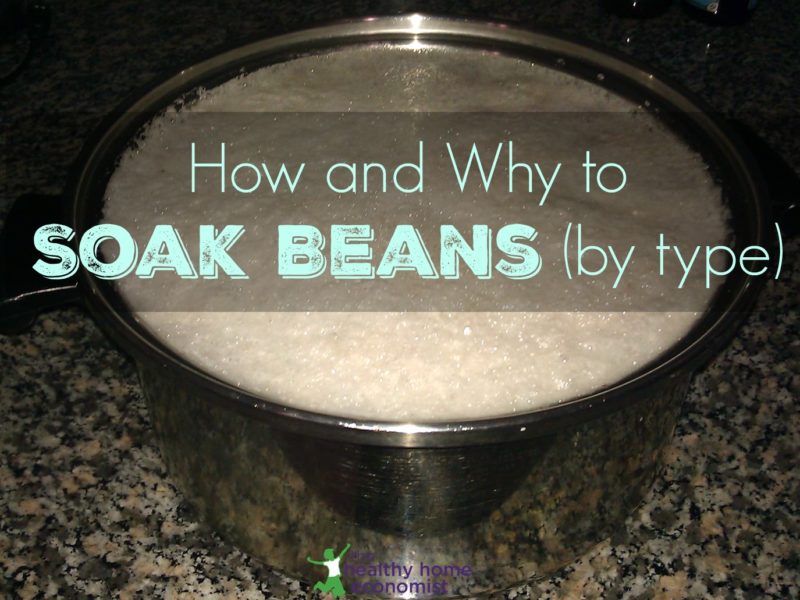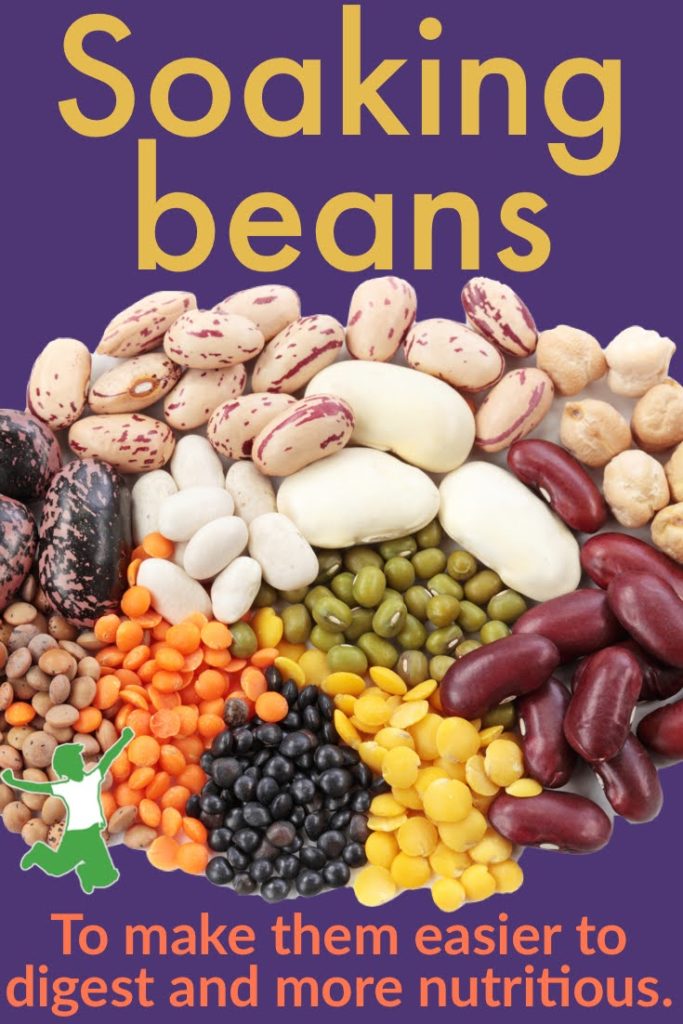Table of Contents[Hide][Show]
The simple overnight process of how to soak beans (by type) will help to eliminate gas and intestinal issues so you can enjoy eating these nutritious plant foods again!

I went on a bean soaking binge this past weekend, and the amount of scum that came to the top of the large pot of soaking kidney beans was so huge, I thought it deserved its own blog post. Soaking beans for many hours before cooking them produces a lot of scum which is course, is rinsed and drained away when the soaking is complete.
What is all that scum anyway? Anti-nutrients, that’s what! And those anti-nutrients such as phytic acid, lectins, and enzyme inhibitors are going to be in your gut causing you gas, heartburn, reflux, and whatever other digestive ills beset you when you eat something that isn’t particularly digestible unless you soak your beans before cooking them.
Traditional cultures took great care to prepare their legumes with a long soak before cooking to enhance digestibility and nutrient absorption.
I love Mexican food but really try to avoid Mexican restaurants for this reason .. they don’t soak their beans before cooking them!
After a meal at a Mexican restaurant, I will typically feel very bloated. Eating the same meal prepared at home where I soaked the beans properly before cooking results in no digestive upset whatsoever.
Take the Soaked Beans Challenge!
If you think unsoaked beans don’t cause you any trouble .. take this challenge. Soak beans next time before cooking and notice the difference in your stomach after eating.
You may think that the unsoaked beans don’t cause you any trouble, but you just may find that soaked beans are infinitely more filling and that you eat less and enjoy the meal more as a result!
Traditional peoples were very wise in the preparation of their foods. They not only selected nutritious foods but they prepared them for maximum digestibility and nutrition.
What good is eating nutritious legumes if the body is so whacked by the anti-nutrients that it can’t very easily extract and digest the nutrition?
So, the next time you make your beans, make sure you soak them first!
I soak large pots of various types of beans every month or so and then cook them – freezing for easy, quick meals when beans are required like homemade chili.
**If you absolutely do not have time to do this, at least buy pre-soaked legumes and beans packed in glass jars. Your digestion will thank you!
How To Prepare Beans by Soaking (video tutorial)
If you’ve never soaked beans before, it’s so easy. It’s a very similar process to soaking nuts. The method also mimics the wisdom of traditional societies that soaked seeds.
See this short video below that demonstrates the simple process.
Kidney shaped beans
For kidney shaped beans and dried/split peas, put a pinch of baking soda and enough water to cover in a large pot and soak uncovered for 12-24 hours. Drain, rinse and cook as usual.
Examples of kidney-shaped beans include:
- Red kidney beans
- White kidney beans (cannellini beans)
- Pinto beans
- Anasazi beans
- Black-eyed beans (black-eyed peas)
- Great Northern beans
- Lima beans
Non-kidney shaped beans (and other legumes)
For more oval-shaped beans and other legumes, soak for 12-24 hours in filtered water to cover plus 1 tablespoon of cider vinegar or lemon juice for every cup of dried beans/legumes used.
A homemade apple cider vinegar recipe or store-bought are both fine (make sure the ACV is packed in glass). Liquid whey from yogurt, kefir, or clabbered milk may also be used. Drain, rinse, and cook as usual.
Examples of non-kidney shaped beans include:
- Black beans (turtle beans)
- Navy beans
- Fava beans
- Adzuki beans
- Chickpeas
- Lentils
For maximum digestibility, it is best to rinse and refresh the filtered water and baking soda or the acidic medium once or twice during the soaking period. If you forget, no worries.
I try to always soak beans for the full 24 hours instead of just overnight. Sometimes if I get busy, I might even soak them 36 hours, but this is risky as they can get moldy sometimes if you go over 24 hours. Best to stay between 12-24 hours particularly during summer months.
How to Cook Beans After Soaking
After soaking, be sure to thoroughly drain and rinse the beans until all the scum is washed away. Then, complete the process by doing the following.
- Fill the pot of rinsed pre-soaked beans with fresh filtered water, bring to a boil, and skim away any additional foam that may come to the top at the start of the boil.
- Turn down the heat to a simmer, add 4 crushed garlic cloves, and cook until the beans are soft (about 4 hours).
- Drain beans and add to your favorite dish or let cool and freeze in large freezer bags for quick meals at a later date!
You won’t be needing over-the-counter gas meds after preparing beans the traditional way!
Should You Use the Soaking or Cooking Water?
Some alternative cooking circles advocate using the soaking or bean cooking water. Unfortunately, neither of these practices is traditional.
Using the cooked bean water or aquafaba is actually a dangerous practice. See the linked article for reasons to avoid this modern food especially during pregnancy!
Other Types of Legumes
This article plus video on soaking lentils provide additional information specifically for this legume. Because they are soaked exactly the same as all non-kidney shaped beans, it is helpful for visual learners.
Lentils were the favorite of nutritional pioneer Dr. Weston A. Price due to their very high potassium content.
Recipes Using Pre-soaked Beans and Legumes
Here are some recipes to try using soaked beans and other legumes to entice you!









“Traditional peoples were very wise in the preparation of their foods. They not only selected nutritious foods but they prepared them for maximum digestibility and nutrition”
This is just bs, they did it soaking the beans, because it was the only method to be able to cook them in a reasonable amount of time (and energy… fire wood), they were not thinking about “digestibility” or “nutrition”.
The fact that is easier to digest and healthier is just a nice side effect NEVER INTENDED.
****important Clarification for soaking Chickpeas****
They DO NOT get an acidic medium….they just get water. An acidic medium only applies to Black, and Fava beans. Your blog site indicates an acidic medium for all beans. I originally took the advice from your blog site and my chickpeas which soaked for a full 24 hours in acidic medium. After 12 hours on low, my chickpeas are still tough.
Ironically,…on the Weston Price Foundation website, an article talks about legumes back in 2007. Here it is…
http://www.westonaprice.org/food-features/putting-the-polish-on-those-humble-beans
Conversely you have a 2011 video clip posted on the WPF website about this same topic, and it is conflicting to the 2007 post.
So…..Please clarify the article on your blog site to coincide with the Weston Price Foundation article, esp. since you are a Florida chapter leader.
Dom
ファンタジー世界
I read with interest the many comments about all the different ways and reasons to SOAK BEANS before cooking, and I didn’t see any comment about the fact that soaking beans overnight cuts down dramatically on the cooking time. It also makes a huge difference in their tenderness. I cooked a pot of black beans without soaking them first and it took forever before they were done, and then, even when they tasted like they were done, they were still kinda hard. Bottom line: SOAKING BEANS CUTS DOWN ON COOKING TIME …… AND RESULTS IN MORE TENDER BEANS !
It’s hard to find educated people for this topic, but you seem like you
know what you’re talking about! Thanks
Hi Sarah-
I just watched a video that you did for WAPF on soaking kidney beans and you said to soak them with a pinch of baking soda- which I did, overnight. Now, I read above that you said soak your beans with an acidic medium. Which is better, does it matter, and why? Thanks! 🙂
Hi there, I found your web ssite by way of Google at the same time as searching for a comparable subject, your
site came up, it looks good. I’ve bookmarked it in my google bookmarks.
Hello there, simply turned into alert to your blog thru Google,
and located that it is really informative. I’m
gonna watch ouut for brussels. I’ll be grateful for those who continue this
in future. Lots of other folks might be benefited from your
writing. Cheers!
I sprout my beans for several days after soaking them which increases the protein content by about 400%. Keep in mind that cooking beans in boiling water is a good choice if you desire a high carbohydrate meal because boiled beans offer little bio-available protein. However, if you want to absorb the 400% extra protein after sprouting your beans, cook them in water at 190 degrees for about an hour. The result is chewy, delicious, highly digestible protein-rich beans. Yum!